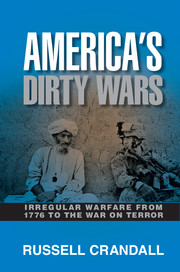Book contents
- Frontmatter
- Dedication
- Contents
- List of Figures
- Acknowledgments
- 1 Introduction
- 2 Irregular Warfare 101
- Part One The American Revolution to Chasing Sandino, 1776–1930s
- Part Two The Cold War, 1940s–1989
- Part Three Latin America and the Cold War, 1950s–1980s
- Part Four Post–Cold War, 1990s–2000s
- 26 Dirty Wars after the Cold War
- 27 Colombia
- 28 Iraq
- 29 Intermezzo
- 30 Post-9/11 COIN in the Philippines
- 31 Intermezzo
- 32 The Longest War
- 33 The Fall of Muammar Qaddafi, 2011
- 34 Intermezzo
- 35 Conclusion
- Epilogue “I Feel More Like a Monster”
- Notes
- Bibliography
- Index
30 - Post-9/11 COIN in the Philippines
Published online by Cambridge University Press: 05 July 2014
- Frontmatter
- Dedication
- Contents
- List of Figures
- Acknowledgments
- 1 Introduction
- 2 Irregular Warfare 101
- Part One The American Revolution to Chasing Sandino, 1776–1930s
- Part Two The Cold War, 1940s–1989
- Part Three Latin America and the Cold War, 1950s–1980s
- Part Four Post–Cold War, 1990s–2000s
- 26 Dirty Wars after the Cold War
- 27 Colombia
- 28 Iraq
- 29 Intermezzo
- 30 Post-9/11 COIN in the Philippines
- 31 Intermezzo
- 32 The Longest War
- 33 The Fall of Muammar Qaddafi, 2011
- 34 Intermezzo
- 35 Conclusion
- Epilogue “I Feel More Like a Monster”
- Notes
- Bibliography
- Index
Summary
The attacks of September 11, 2001, pushed President George W. Bush to actively combat terrorist networks around the globe, most visibly in Afghanistan where the fight against the Taliban and Al Qaeda captured the world’s attention. At the same time the American military was searching for Osama bin Laden and hunting Taliban insurgents in their isolated mountain strongholds of Afghanistan, the U.S. military initiated a number of smaller-scale operations in a variety of disparate locations that took a more indirect approach toward defeating terrorist groups.
The Philippines – a recurring counterinsurgency battleground ever since the colonial wars at the turn of the twentieth century and the Magsaysay years of the 1950s – would become one example of America’s post-9/11 attempts to target the world’s murky and lawless areas that nurtured and fueled the spread of global terrorism and insurgency. While the indirect U.S. military effort in the Philippines would receive scant media coverage, it stands as an important but overlooked case of light-footprint counterinsurgency that, in the shadow of the full-scale invasion of Afghanistan, demonstrates the diversity of the American experience with counterinsurgency warfare in the heady moments of the post-9/11 era.
- Type
- Chapter
- Information
- America's Dirty WarsIrregular Warfare from 1776 to the War on Terror, pp. 398 - 403Publisher: Cambridge University PressPrint publication year: 2014



